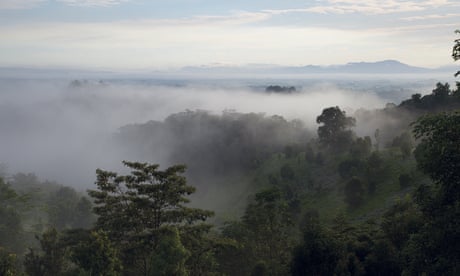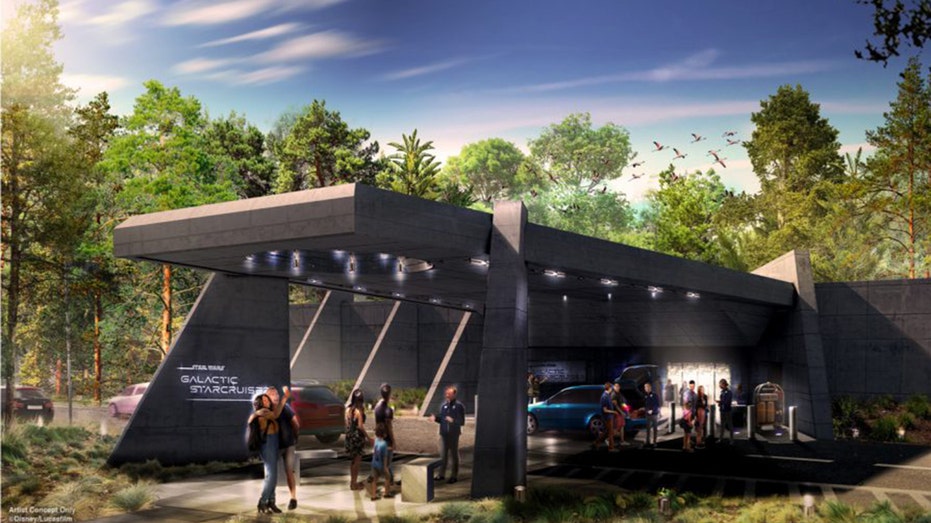- by foxnews
- 02 Feb 2025
‘Our fate rests on efforts like this’: the family restoring precious rainforest to its former glory
‘Our fate rests on efforts like this’: the family restoring precious rainforest to its former glory
- by theguardian
- 05 Feb 2023
- in news

My relationship with Thiaki started with an ambush. It wasn't your usual ambush, but it was an ambush, nevertheless. We'd crept along a narrow track that ran atop a volcanic ridge, the sound of crunching gravel under the car's wheels muffled by a narrow strip of trees edging the track. We came to the back of a brick house, which had a neat lawn adorned with a cement girl holding a concrete birdbath. Sheds were stacked with rainforest timber, and cattle yards were perched further ahead at the end of the ridge.
Ridges with level ground were in short supply on the random boneless volcanic landscape of the Atherton Tablelands. A scruffy dingo-dog cross and a couple of cats lounged near the roller-door entrance, lazily observing the proceedings as their owners shook our hands in formal welcome and ushered us into a large living space: concrete floor, Laminex-surfaced table and metal chairs, no fuss.
Suddenly, we saw something captivating through the large east-facing window. Concealed up until now was a jungled landscape with the highest mountain in Queensland, Mount Bartle Frere, sheathed in shifting cloud on the horizon. Draped in mist, the rainforest exhaled a long, slow, yogic-like breath; it created a ghostly play of shapes and forms, like an exhumation of prehistoric creatures from a deep memory. They drifted upwards in sinuous lines, dissipating as they merged into the warming air. The rainforest, etched by the rising sun, was a preternatural presence: aloof, almost sentient in its self-awareness. But with as many individual organisms as cells in the human brain, it was hardly an "it". Nor a he or she. I was looking at "them".
I looked sideways at the profiles of my husband and son, who were slack-jawed in wonder. I guess we'd have to buy them, then: this patch of forest called Thiaki was for sale. I'd discovered them on the internet just a few weeks before. I was aware of the absurdity of it, like a short-lived bacterium in my gut deciding it needed to buy me. Nevertheless, this forest could be ours for the short microbial life left to us.
A rainforest is not just timber and trees, an annoying cloying clumping of jumble and tangle, endless and meaningless. Glances are intimate, complex, incomprehensible: shattered sunlight and torn sky, vertical rivers of rain, unearthly mist, trees flowered with stars on clear nights, and rivers of sky above sonorous streams. A rainforest's silences are a polyphony of subtle, ceaseless, scintillating noises. A humid wet chaos of activity. The scented wind is alive, complex, mouldy and sweet, earthy, varietal: an evolutionary vintage. Distillations of ancient plants embody the living history of living plants. Three hundred million years ago - and beyond - a bridge formed between reality and magic, potent with memories that go deep in time, like dreams hardwired into grey matter.
At the scene of our ambush, things were heating up. The tropical sun of far-north Queensland burned away the mist to reveal the patchwork landscape of the Atherton Tablelands over which Thiaki broods, clinging to foothills at 1,000 metres. Seeing our stupefied expressions - and no doubt thinking of the sale - Barry, the owner said, "Want to go have a look?" We jumped into the back of his ute and held on to the tray. His place was called Ups and Downs, and that's exactly what it was.
Much of the land like this was "up to shit", according to a settler of one of the last areas opened for clearing in 1954, 18km from Thiaki. He had to hang on to tree trunks as he was brush-hooking around steep hills, all while it was raining like hell. The same settler wrote in 1979 that you needed "a fistful of dollars, a big heart, no brains and a bloody big umbrella" to farm this country. He wished he'd walked off it in 1954. The soil proved marginal for farming and, once cleared and burned, it reverted to a maelstrom of weedy lantana, bracken and tobacco bush when the farm was abandoned. All but 4% of the 80,000 hectares of rainforest on the Atherton Tablelands were razed for the yeoman's idyll of smiling homesteads, rosy-cheeked children and plump wives, , which only dissipated with the world heritage listing of the wet tropics in 1988.
Thrilled with the place, we bought Thiaki in 2005: our 180 hectares comprised 130 hectares of logged but intact forest and a steep 50-hectare paddock. With value measured in cows, we would struggle to make a living from Thiaki even though rainforest was among the most biologically valuable pieces of land in the country. At best we would receive $5,000 a year agisting Barry's cattle in the precipitous paddock - which was too steep for crops - where the cattle had trampled narrow terraces, like linear paddies, on which to walk along contours.
The wet tropics cover a minuscule 0.3% of Australia's landscape but support more species diversity than any other place on the continent. Thiaki is at the western extremity of the world heritage area and about 1km from one of its convoluted boundaries. The nearest town is Malanda, 15km to the north by road.
While it hadn't been easy to turn lush tropical rainforest into paddocks - some individual settlers worked at it for decades - how could you turn paddocks back into rainforest? Local efforts on the Atherton Tablelands to restore degraded land back to rainforest were heroic but ad hoc. Community efforts relied on meagre government environment funding and focused on planting dense stands of native seedlings to form an instant closed canopy. It was expensive - about $60,000 a hectare - so only a few tens of hectares were planted. No matter how carefully the plants were placed (such as along creek lines), this expensive approach could not underpin the landscape-scale change that was desperately needed to restore the country to any semblance of its former glory.
So, with colleagues from several universities and some of our own funds as leverage, we pitched an idea to the Australian Research Council during one of their annual rounds. We were jubilant when, a year later, in 2008, we heard that our application was successful. We would aim to tease out restoration methods that maximised benefits to conservation by working with the rainforest and allowing it some agency, while at the same time providing an income through carbon sequestration. We would set up one of the few experimental demonstration reforestation sites in the world to examine different approaches and associated costs.
So far so good. Work commenced apace to design the reforestation research plan for the foundations of a brand-new rainforest that uses different mixes and numbers of native species with different planting densities. There would also be grass-management systems with no plantings to see if the rainforest would kickstart restoration itself. On 28 January 2011, a bunch of academics and a crack team of planters with dirt under their fingernails and dreadlocks like flowing lianas, assembled to build the foundations of a rainforest with 30,000 plants, and to create the conditions for a phoenix to rise once more from the ashes.
The date in January was important. Noel had looked back as far as rainfall records went to see when rain would be a given and the ground would be guaranteed to be wet enough to accept our seedlings. But as the week progressed into February, the sky became clearer and the weather hotter. Strange streaks appeared across the blue. It was ominously still and a silver gull fled from the coast over the ranges inland. It was a warning. Something was sucking away our weather.
Six days of planting later and a day after the last seedling went into dry ground, Severe Tropical Cyclone Yasi - category 5 and one of biggest cyclones ever to cross the coast - roared across the Coral Sea and over Thiaki.
Quite ironically, it was the irksome grass that saved the day. We had left grass between the weed-sprayed rows of young seedlings, to reduce costly pesticide use and protect the soil microbiome, and the grass had blown over the seedlings, shielding them protectively against the 250km/h winds that raked the landscape.
The clearing frenzy of the first 20 years of the 20th century brought about the near extinction of the upland rainforest on the Atherton Tablelands. And forces like Cyclone Yasi have tried to undo our efforts at restoration.
My gaze slides to the pert trees in our restoration plots - also an unstoppable force. Unless we suddenly find the ability to take to the stars, our fate rests on efforts like this.
This is an edited extract from Cloud Land - The dramatic story of Australia's extraordinary rainforest people and country, by Penny van Oosterzee, published by Allen & Unwin
- by foxnews
- descember 09, 2016
Disney reveals fate of closed Star Wars hotel
The building that was formerly home to the Star Wars: Galactic Starcruiser at Walt Disney World in Orlando, Florida will be repurposed, the company confirmed to local media earlier this week.
read more


